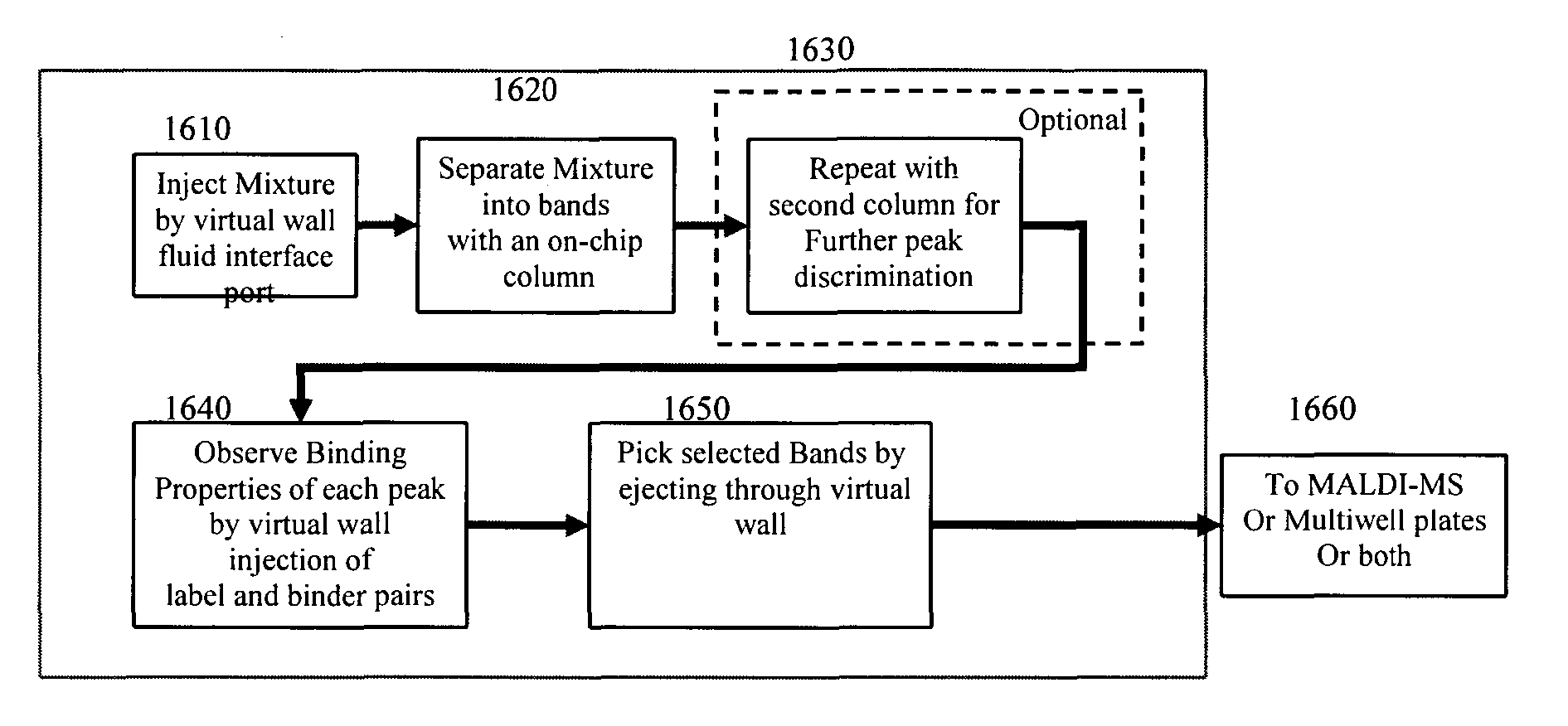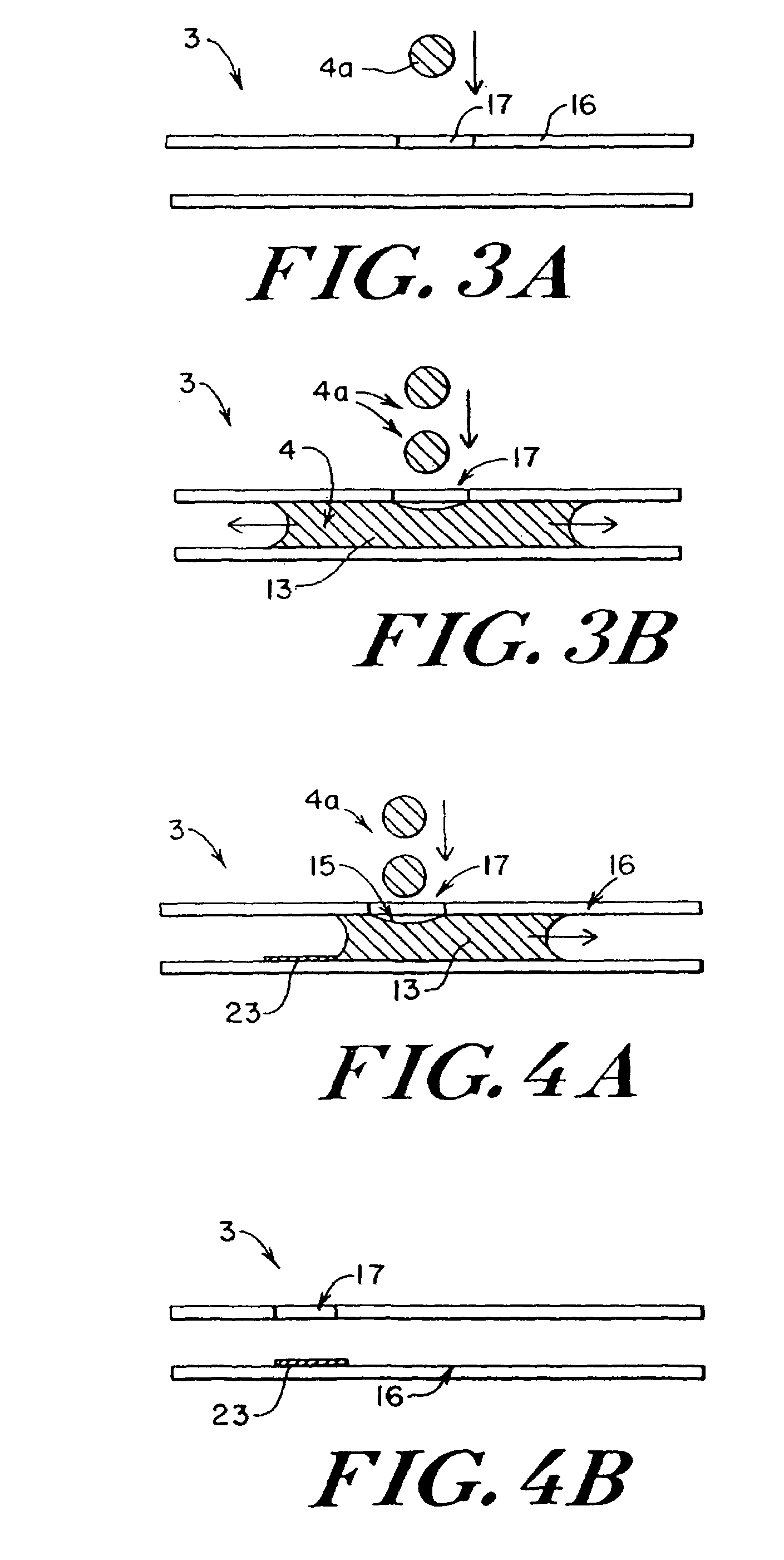Another example of the efficiency of microfluidic systems is the mixing of dissolved species in a liquid, a process that is also
diffusion limited.
In conventional microfluidic systems, the structures and methods used to introduce samples and other fluids into microfluidic substrates limit the capabilities of the microfluidic systems.
The total number of samples and other fluids that can be processed on a microfluidic substrate is currently limited by the size and / or the number of reservoirs through which these fluids are introduced to the microfluidic system.
A
disadvantage of known structures and methods for introducing fluids into a microfluidic system is the use and transfer of a much greater volume of fluid than is needed for
microfluidic analysis due to significant size inefficiencies and sample loss.
Furthermore, with conventional methods of introducing fluids into microfluidic systems, it is difficult to control the amount of sample introduces that is eventually introduces into the microchannel after passing through a sample channel or a reservoir.
A major
disadvantage of this approach for fluidic
interfacing is the complex construction and operation of these micropumps and valves.
Another
disadvantage is there relatively
large size and internal volume when compared to the internal volume of the microchannels.
Often there are multiple orders of magnitude between these two volumes and the resulting discrepancy renders micropumps unattractive to interface with a large number of small dimensional microchannels.
The size of the device does not allow the
interfacing with a large number of microchannels, and between consecutive injections, the device needs to be cleaned, thereby considerably reducing
throughput.
A disadvantage is that the precise amount of injected liquids and substances depends upon a large number of factors which are difficult to control.
It is also a disadvantage that it does not allow the efficient interfacing with a large number of different liquids as for every
injection port, a separate
high voltage supply is required, together with the associated liquid channels for providing a closed electrical circuit.
A disadvantage is that only a very small fraction of the applied liquid is actually introduced in the target microchannel, the bulk of the applied
liquid drop remains behind in the well by capillary forces.
As a result, most of the liquid is wasted and is not available for a consecutive chemical
processing step.
A low injection efficiency is disadvantageous because it indicates inefficient use of chemical substances and an increased production of waste.
Besides the complexity of the required fluidic manifolds and pressurizing system, also here a disadvantage is the inherently low injection efficiency as only a very small fraction of the applied liquid is actually used in the experiment.
One disadvantage is that if a large number of liquids need to be handled, for instance in high-
throughput synthesis and screening applications, a large number of wells need to be integrated on the microfluidic device.
As the costs of microfluidic chips strongly depends on the
chip surface, the required integration of wells renders this
liquid injection scheme unattractive for high-
throughput synthesis and screening applications.
Another disadvantage of conventional systems is that for every well, a separate
electrode is required together with electronic circuitry for the application of the driving voltages.
This requirement results in a complex and expensive apparatus.
Another specific disadvantage with electrokinetic injection is the fact that during the application of the driving
voltage on the
electrode the
electrolysis of water results in the generation of hydroxyl ions (OH−),
hydrogen ions (H+),
hydrogen gas (H2) and
oxygen gas (O2).
The generated ions will affect the acidity (i.e. pH) of the liquid pumped from the first well, whilst the produced gasses potentially give rise to the formation of gas bubbles in the microfluidic system thereby destroying the experiment and eventually the microfluidic device.
For instance, the presence of
chloride ions, an
ion present in most liquid media, will result in the formation of
chlorine gas, which on turn can interact and potentially destroy vulnerable (biochemical) compounds present in the liquid to be injected.
Another disadvantage of electrokinetic injection is that in between consecutive experiments, the well need to be thoroughly cleaned in order to prevent cross-
contamination.
This required cleaning step results in a reduction of throughput and makes it difficult to implement on-line monitoring.
Another disadvantage is that the liquid to be injected is subjected to a
high voltage.
This aspect of the absence of galvanic separation makes it virtually impossible to use electrokinetic injection for in-vivo or near-vivo applications due to the danger of
electrocution.
Another disadvantage is that the electrokinetic injection methods referred to, are only applicable in
chip like systems produced via
microfabrication technology, i.e. via the use of expensive equipment and processes also applied for the fabrication of computer chips.
These methods are known to have high costs.
Still another disadvantage is the low injection efficiency of electrokinetic injection.
A disadvantage of this fluidic interfacing method is that for a correct and efficient operation the pressure generating
air chamber together with electronic heater components need to be integrated with the microfluidic system.
This results in a complex device with associated large costs.
It can be concluded based on the above that current methods and systems for fluidic interfacing with microfluidic devices have particular disadvantages regarding the difficulty of integration of a large number of chemical operation nodes to interface with (i.e.
electrochromatography columns, reactors etc.), relatively large required liquid volumes, low injection efficiency, electrochemical sample
pollution, long rinse time between analysis steps, galvanic separation and required
microfabrication technologies.
Besides these disadvantages, none of the above mentioned interfacing methods allow bi-directional fluidic interfacing, i.e. transporting liquids to and from microfluidic systems.
 Login to View More
Login to View More 


